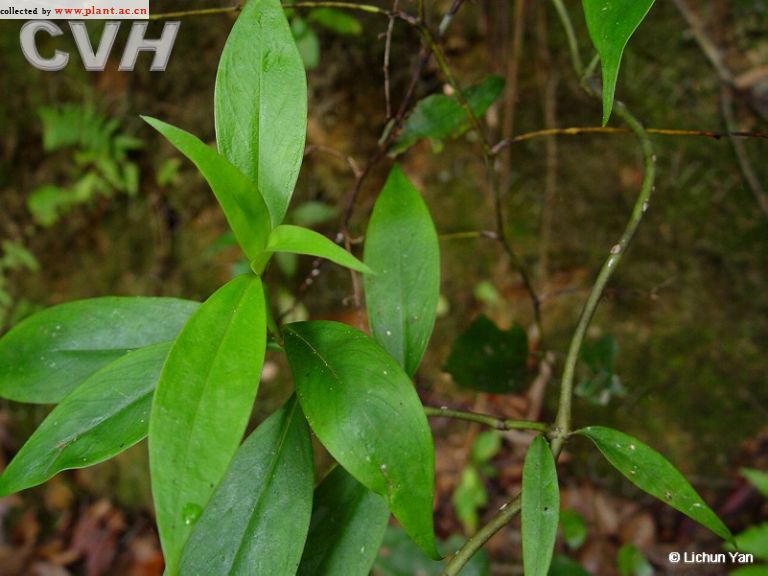攀茎耳草Hedyotis scandens Roxb.
攀茎耳草Hedyotis scandens Roxb.
48. 攀茎耳草(新拟)凉喉茶 图版12: 7-10
Hedyotis scandens Roxb. (Hort Beng. 10. 1814, nom. nud.) Fl. Ind. ed. Carey 1: 369. 1820; D. Don; Prodr. Fl. Nepal 134. 1825; DC. Prodr. 4: 422. 1830; Hook. f. Fl. Brit. Ind. 3: 57. 1880; Levl. Cat. Pl. Yunnan 241. 1917; Chung in Mem. Sci. Soc. China 1: 234. 1924. ——Oldenlandia scandens (Roxb.) Kuntze, Rev. Gen. Pl. 1: 292. 1891; Pitard in Lecomte, Fl. Gen. Indo-Chine 3: 140. 1922.
多分枝藤状灌木,除花外其余各部无毛;嫩枝扁圆柱形,后变圆柱形,灰褐色。叶对生,近革质,长圆状披针形或狭椭圆形,通常长5-10厘米,宽3-4厘米或不及,顶端长渐尖,有时尾状长尖,基部楔形;侧脉每边4-5条,极柔弱,与中脉成锐角向上伸出;叶柄长2-3毫米;托叶膜质,基部合生,上部全缘,仅中央具1尖头,有微小缘毛。聚伞花序排成扩展的圆锥花序式,顶生,罕有腋生;花4数,有长2-3毫米的花梗;萼管倒圆锥形,长约1毫米,萼檐裂片卵形,与萼管近等长,短尖;花冠白色或黄色,管形,长6毫米,花冠裂片长圆形,长约4毫米,宽1-1.2毫米,外反,里面被髯毛;雄蕊生于冠管基部,花丝中部以下被毛,花药长1.2毫米;花柱长约4毫米,略短于雄蕊,中部被长毛,柱头2裂;裂片长2毫米。蒴果扁球形,顶部隆起,长和宽3-5毫米,宿存萼檐裂片短,成熟时室间开裂为2果爿,每个果爿腹部直裂,内有种子数粒;种子微小,有棱,干后黑色。花期7-8月。
产于云南;生于疏林内或山谷湿润土壤上。国外分布于印度、越南。
《Flora of China》 Vol. 19 (2011)
Hedyotis scandens Roxburgh Fl. Ind. 1: 369. 1820.
攀茎耳草 pan jing er cao
Oldenlandia scandens (Roxburgh) Kuntze.
Shrubs or herbs, perennial, lianescent, climbing, or scandent, to several meters; stems compressed terete to angled, smooth or sulcate, glabrous or puberulent in lines. Leaves subsessile to petiolate; petiole to 5 mm, glabrous; blade drying papery to subleathery, pale abaxially, oblong-lanceolate, elliptic, narrowly elliptic, or elliptic-oblong, 5-10 × 1.5-4 cm, glabrous, base acute to cuneate then decurrent, apex long acuminate; secondary veins 3-5 pairs but not evident; stipules fused to petiole bases, truncate to triangular, 2.5-4 mm, glabrous to usually puberulent or strigillose, ciliolate to entire, apex acute to acuminate or bilobed, sometimes glandular and/or with bristle inserted below top of stipule. Inflorescences terminal and usually also in axils of uppermost leaves, cymose to compound-cymose, 2-15 cm, densely pilosulous or hirtellous, pedunculate; peduncles 2-3 cm; bracts triangular to narrowly triangular, 0.3-6 mm; pedicels 1-3 mm. Flowers pedicellate, distylous. Calyx glabrous; hypanthium portion obconical, ca. 1 mm, sometimes ridged; limb 1-2 mm, lobed for 1/3-1/2, lobes triangular and thickened, sometimes costate. Corolla white or yellow, tubular-funnelform to funnelform, outside glabrous [or puberulent in India], inside densely villous in throat and throughout lobes; tube 1-2 mm; lobes narrowly spatulate-oblong to narrowly triangular, 3-4 mm, acute. Anthers shortly to long exserted, ca. 1.2 mm. Stigmas 0.3-1 mm. Fruit capsular, subglobose, ellipsoid, or ovoid, 3-5 × 3-5 mm, glabrous, cartilaginous to stiffly papery, loculicidally dehiscent across top then sometimes septicidal, beak rounded to conical, 1.2-2 mm; seeds several, black, angled. Fl. Jul-Sep, fr. Aug-Sep.
Sparse forests, on humid soil in valleys; 1000-1800 m [as low as ca. 700 m in India]. Yunnan [Bangladesh, Bhutan, India, Myanmar, Nepal, Vietnam].
别名:凉喉茶;鹩哥舌;莫爪腊;凉猴茶;老人拐掍;大接骨草;理肺散;老人拐棍;攀援耳草;攀缘耳草;羊梅功;接骨丹;
科名:茜草科 Rubiaceae
属名:耳草属 Hedyotis

48. 攀茎耳草(新拟)凉喉茶 图版12: 7-10
Hedyotis scandens Roxb. (Hort Beng. 10. 1814, nom. nud.) Fl. Ind. ed. Carey 1: 369. 1820; D. Don; Prodr. Fl. Nepal 134. 1825; DC. Prodr. 4: 422. 1830; Hook. f. Fl. Brit. Ind. 3: 57. 1880; Levl. Cat. Pl. Yunnan 241. 1917; Chung in Mem. Sci. Soc. China 1: 234. 1924. ——Oldenlandia scandens (Roxb.) Kuntze, Rev. Gen. Pl. 1: 292. 1891; Pitard in Lecomte, Fl. Gen. Indo-Chine 3: 140. 1922.
多分枝藤状灌木,除花外其余各部无毛;嫩枝扁圆柱形,后变圆柱形,灰褐色。叶对生,近革质,长圆状披针形或狭椭圆形,通常长5-10厘米,宽3-4厘米或不及,顶端长渐尖,有时尾状长尖,基部楔形;侧脉每边4-5条,极柔弱,与中脉成锐角向上伸出;叶柄长2-3毫米;托叶膜质,基部合生,上部全缘,仅中央具1尖头,有微小缘毛。聚伞花序排成扩展的圆锥花序式,顶生,罕有腋生;花4数,有长2-3毫米的花梗;萼管倒圆锥形,长约1毫米,萼檐裂片卵形,与萼管近等长,短尖;花冠白色或黄色,管形,长6毫米,花冠裂片长圆形,长约4毫米,宽1-1.2毫米,外反,里面被髯毛;雄蕊生于冠管基部,花丝中部以下被毛,花药长1.2毫米;花柱长约4毫米,略短于雄蕊,中部被长毛,柱头2裂;裂片长2毫米。蒴果扁球形,顶部隆起,长和宽3-5毫米,宿存萼檐裂片短,成熟时室间开裂为2果爿,每个果爿腹部直裂,内有种子数粒;种子微小,有棱,干后黑色。花期7-8月。
产于云南;生于疏林内或山谷湿润土壤上。国外分布于印度、越南。
《Flora of China》 Vol. 19 (2011)
Hedyotis scandens Roxburgh Fl. Ind. 1: 369. 1820.
攀茎耳草 pan jing er cao
Oldenlandia scandens (Roxburgh) Kuntze.
Shrubs or herbs, perennial, lianescent, climbing, or scandent, to several meters; stems compressed terete to angled, smooth or sulcate, glabrous or puberulent in lines. Leaves subsessile to petiolate; petiole to 5 mm, glabrous; blade drying papery to subleathery, pale abaxially, oblong-lanceolate, elliptic, narrowly elliptic, or elliptic-oblong, 5-10 × 1.5-4 cm, glabrous, base acute to cuneate then decurrent, apex long acuminate; secondary veins 3-5 pairs but not evident; stipules fused to petiole bases, truncate to triangular, 2.5-4 mm, glabrous to usually puberulent or strigillose, ciliolate to entire, apex acute to acuminate or bilobed, sometimes glandular and/or with bristle inserted below top of stipule. Inflorescences terminal and usually also in axils of uppermost leaves, cymose to compound-cymose, 2-15 cm, densely pilosulous or hirtellous, pedunculate; peduncles 2-3 cm; bracts triangular to narrowly triangular, 0.3-6 mm; pedicels 1-3 mm. Flowers pedicellate, distylous. Calyx glabrous; hypanthium portion obconical, ca. 1 mm, sometimes ridged; limb 1-2 mm, lobed for 1/3-1/2, lobes triangular and thickened, sometimes costate. Corolla white or yellow, tubular-funnelform to funnelform, outside glabrous [or puberulent in India], inside densely villous in throat and throughout lobes; tube 1-2 mm; lobes narrowly spatulate-oblong to narrowly triangular, 3-4 mm, acute. Anthers shortly to long exserted, ca. 1.2 mm. Stigmas 0.3-1 mm. Fruit capsular, subglobose, ellipsoid, or ovoid, 3-5 × 3-5 mm, glabrous, cartilaginous to stiffly papery, loculicidally dehiscent across top then sometimes septicidal, beak rounded to conical, 1.2-2 mm; seeds several, black, angled. Fl. Jul-Sep, fr. Aug-Sep.
Sparse forests, on humid soil in valleys; 1000-1800 m [as low as ca. 700 m in India]. Yunnan [Bangladesh, Bhutan, India, Myanmar, Nepal, Vietnam].

